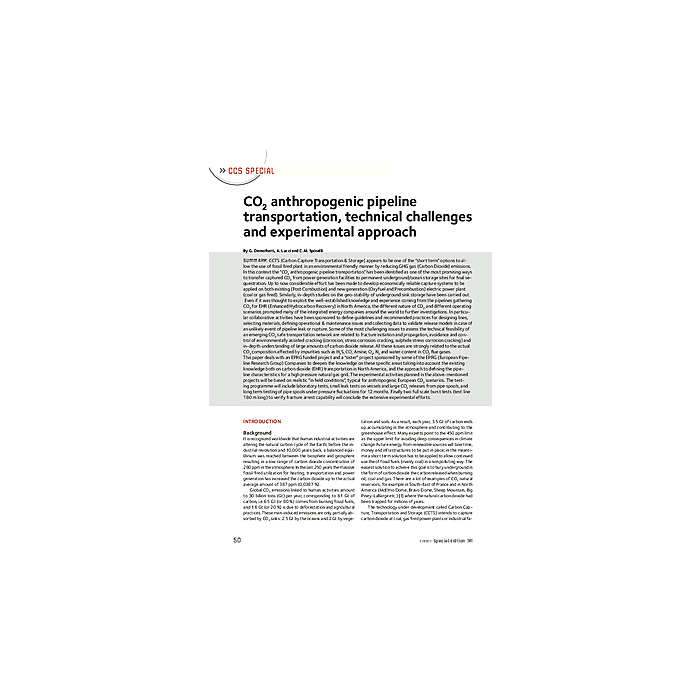CO2 anthropogenic pipeline transportation, technical challenges and experimental approach
4,90 €
Auf Lager
Artikelnummer
01252_2011_SP1_09
SUMMARY: CCTS (Carbon Capture Transportation & Storage) appears to be one of the "short term" options to allow the use of fossil fired plant in an environmental friendly manner by reducing GHG gas (Carbon Dioxide) emissions. In this context the "CO2 anthropogenic pipeline transportation" has been identified as one of the most promising ways to transfer captured CO2 from power generation facilities to permanent underground/ocean storage sites for final sequestration. Up to now considerable effort has been made to develop economically reliable capture systems to be applied on both existing (Post Combustion) and new generation (Oxyfuel and Precombustion) electric power plant (coal or gas fired). Similarly, in-depth studies on the geo-stability of underground sink storage have been carried out. Even if it was thought to exploit the well-established knowledge and experience coming from the pipelines gathering CO2 for EHR (Enhanced Hydrocarbon Recovery) in North America, the different nature of CO2 and different operating scenarios prompted many of the integrated energy companies around the world to further investigations. In particular collaborative activities have been sponsored to define guidelines and recommended practices for designing lines, selecting materials, defining operational & maintenance issues and collecting data to validate release models in case of an unlikely event of pipeline leak or rupture. Some of the most challenging issues to assess the technical feasibility of an emerging CO2 safe transportation network are related to fracture initiation and propagation, avoidance and control of environmentally assisted cracking (corrosion, stress corrosion cracking, sulphide stress corrosion cracking) and in-depth understanding of large amounts of carbon dioxide release. All these issues are strongly related to the actual CO2 composition affected by impurities such as H2S, CO, Amine, O2, N2 and water content in CO2 flue gases. This paper deals with an EPRG funded project and a "sister" project sponsored by some of the EPRG (European Pipeline Research Group) Companies to deepen the knowledge on these specific areas taking into account the existing knowledge both on carbon dioxide (EHR) transportation in North America, and the approach to defining the pipeline characteristics for a high pressure natural gas grid. The experimental activities planned in the above-mentioned projects will be based on realistic "in field conditions", typical for anthropogenic European CO2 scenarios. The testing programme will include laboratory tests, small leak tests on vessels and large CO2 releases from pipe spools, and long term testing of pipe spools under pressure fluctuations for 12 months. Finally two full scale burst tests (test line 180 m long) to verify fracture arrest capability will conclude the extensive experimental efforts.
| Autoren | G. Demofonti/A. Lucci and C.M. Spinelli |
|---|---|
| Erscheinungsdatum | 30.04.2011 |
| Format | |
| Zeitschrift | 3R - Special 1 2011 |
| Verlag | Vulkan-Verlag GmbH |
| Sprache | English |
| Seitenzahl | 9 |
| Titel | CO2 anthropogenic pipeline transportation, technical challenges and experimental approach |
| Beschreibung | SUMMARY: CCTS (Carbon Capture Transportation & Storage) appears to be one of the "short term" options to allow the use of fossil fired plant in an environmental friendly manner by reducing GHG gas (Carbon Dioxide) emissions. In this context the "CO2 anthropogenic pipeline transportation" has been identified as one of the most promising ways to transfer captured CO2 from power generation facilities to permanent underground/ocean storage sites for final sequestration. Up to now considerable effort has been made to develop economically reliable capture systems to be applied on both existing (Post Combustion) and new generation (Oxyfuel and Precombustion) electric power plant (coal or gas fired). Similarly, in-depth studies on the geo-stability of underground sink storage have been carried out. Even if it was thought to exploit the well-established knowledge and experience coming from the pipelines gathering CO2 for EHR (Enhanced Hydrocarbon Recovery) in North America, the different nature of CO2 and different operating scenarios prompted many of the integrated energy companies around the world to further investigations. In particular collaborative activities have been sponsored to define guidelines and recommended practices for designing lines, selecting materials, defining operational & maintenance issues and collecting data to validate release models in case of an unlikely event of pipeline leak or rupture. Some of the most challenging issues to assess the technical feasibility of an emerging CO2 safe transportation network are related to fracture initiation and propagation, avoidance and control of environmentally assisted cracking (corrosion, stress corrosion cracking, sulphide stress corrosion cracking) and in-depth understanding of large amounts of carbon dioxide release. All these issues are strongly related to the actual CO2 composition affected by impurities such as H2S, CO, Amine, O2, N2 and water content in CO2 flue gases. This paper deals with an EPRG funded project and a "sister" project sponsored by some of the EPRG (European Pipeline Research Group) Companies to deepen the knowledge on these specific areas taking into account the existing knowledge both on carbon dioxide (EHR) transportation in North America, and the approach to defining the pipeline characteristics for a high pressure natural gas grid. The experimental activities planned in the above-mentioned projects will be based on realistic "in field conditions", typical for anthropogenic European CO2 scenarios. The testing programme will include laboratory tests, small leak tests on vessels and large CO2 releases from pipe spools, and long term testing of pipe spools under pressure fluctuations for 12 months. Finally two full scale burst tests (test line 180 m long) to verify fracture arrest capability will conclude the extensive experimental efforts. |
Eigene Bewertung schreiben


